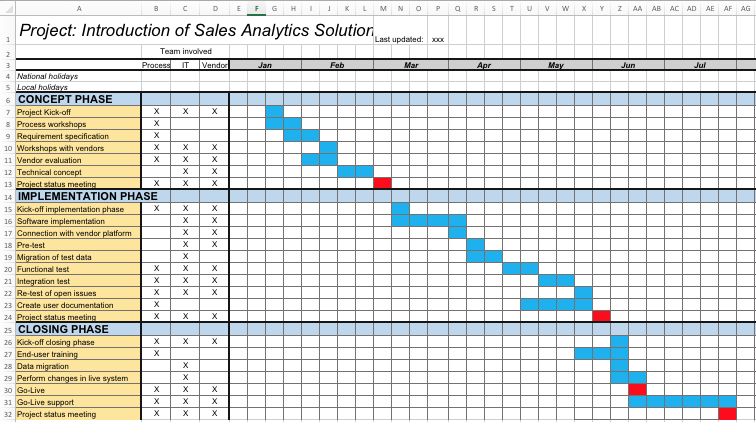Project management has its own terminology and abbreviations, making your entry into the field pretty hard. Our definitions of the most common project management terms will prepare you for the next project meeting.

Agile
Agile or (agile development) is a modern approach to software development, where the product (i.e. the software) is built in multiple cycles, with the customer regularly testing, while the software is being built.
Contrast this with a more fixed approach, where the customer first lists all his requirements, the developer then goes on to implement everything until the last bit is realized, and the customer is being presented the end product.
The agile approach is more flexible and allows the customer to regularly give feedback and thus influence the outcome.
Why is this a good thing? In a nutshell, the agile process lowers the risk of the customer not being satisfied with the end product.
- The customer can re-prioritize his requirements during the development of the software. He can say “oh, actually this feature is more important to me than that one. Please add this first.”
- The customer can request additional features that were forgotten in the initial specification (“I need an additional button here.”).
backlog
The term backlog is used in the agile development process. It’s a list of features or technical tasks that have to be carried out in order to reach a project’s goal or to complete a release. Here’s an example of an actual backlog:
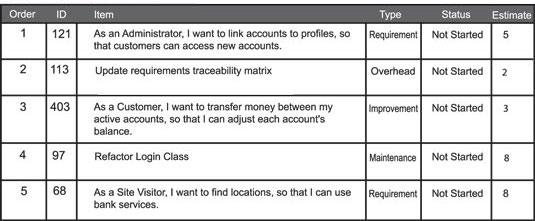
As you can probably guess, a backlog is a “living” document which is constantly updated depending on the project’s status.
baseline
When you plan a new project, there’s an agreement of what shall be accomplished, the schedule, how much budget is required and other things. This initial agreement is called the baseline, and it is used to measure the performance of a project.
Measuring project performance:
- Are we still within schedule?
- Are we still within budget?
- Are we using our resources (time and money) in an efficient way?
The point is you can only make a meaningful call about these questions if you have something to measure against. And this is the baseline.
In an actual project, the way you create a baseline is by making a copy of the project plan, the scope documents and the budget calculation and store it under at a place where it cannot be modified anymore (for example as a PDF). Basically you freeze the status of those documents so that you can always refer back later to what was initially discussed and agreed.
buffer
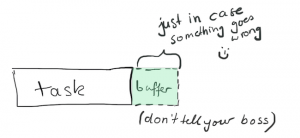 There is a lot of uncertainty in every project, especially when it comes to estimating how long a certain task will take. In an engineering project for example, it may be hard for the PM to estimate how long the design of a new machine will take.
There is a lot of uncertainty in every project, especially when it comes to estimating how long a certain task will take. In an engineering project for example, it may be hard for the PM to estimate how long the design of a new machine will take.
If all goes well, his team of 5 engineers should be able to complete the design within 3 months, given that they work on it two days per week.
But what if one of his team falls ill? What if there’s a computer outage? 3 months for completing the design may be quite optimistic. That’s why the project manager decides to give his team two more weeks, just in case! The two weeks are the buffer.
A buffer is the additional time you factor into your project plan to ensure a project isn’t delayed when some of the sub-tasks get delayed. Buffer is also called contingency, and the concept can also be applied to the project budget.
![]() My article how to set deadlines also talks about calculating buffer.
My article how to set deadlines also talks about calculating buffer.
business case
A business case is a written statement which explains why a project was initiated.
Maybe a company is loosing customers and decides to launch a project to improve customer retention. Or a business may decide to overhaul its IT infrastructure because it’s old and unstable. The reasoning for such a project is described in a business case document, and it usually includes numbers that are supposed to prove why the project makes sense.
CAPM
CAPM stands for Certified Associate in Project Management and it is a very popular project management certification for people who either want to get into project management or who are managing projects part-time.
change request
A change request is a formal document which describes a change to be made to the project plan or project scope.
What is a change and why it is made?
Example 1: Let’s assume you manage a construction project for the construction of a tunnel. Originally a minimum tunnel height of 4 meters was agreed with the city council. Two months into the project, the city council comes to the conclusion that the tunnel should measure at least 4,5 meters in height so that super-large trucks can pass through.
Example 2: You are developing a new software for an external customer that is used for handling inbound customer calls. The contract with the customer states that you will take over the connection of the new software with the customer’s existing ERP solution. During closing phase, the customer side refuses to sign the acceptance sheet because they also demand an interface with another IT system, which nobody thought of before.
Both examples are cases when a change request must be created. In both situations, the requested changes have an impact on the project timeline and on the cost. The change request must be specified by the customer and approved by the project steering committee.
communication plan
Your most important job as a project manager is to make communication happen. Communication is the all-cure in every project.
Why is that? Think of a project as a complex network of inter-dependent activities. Whatever one team does (e.g. write a concept) has implications for another team (e.g. the developer or the end-user). If these people don’t talk to each other, this will lead to misunderstandings, which again can lead to delays.
The best way how you can ensure communication is to set up a communication plan right from the start. This is a plan which states how often and when the different work streams in a project are supposed to meet for discussing current topics. Here’s an example of a communication plan:
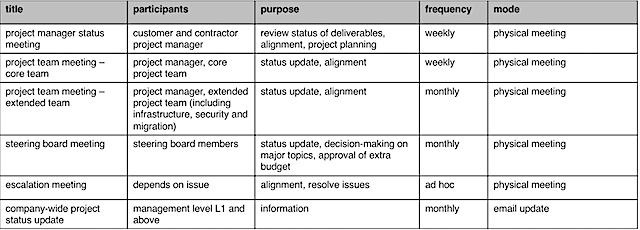
Read also: how to create a communication plan
contingency
Contingency is the extra time or funds you add to a project task to account for uncertainty.
Example: The delivery of machine parts from Dallas to Chicago usually takes 20 hours. Due to heavy traffic over Thanksgiving you add an extra 6 hours as contingency.
critical path
The critical path is a method to calculate the minimum time it will take for a project to complete, considering all dependencies between the individual project activities and assuming everything goes well.
Equally, the critical path method is used to determine which tasks are critical in the sense that if there’s a delay in the activity, the entire project will be delayed. The sum of these critical tasks make up the so-called critical path.
Here’s an example (click to enlarge image):

Take a look at the above image which shows a simple project schedule.
- Above each activity you can see in which week the task will start and when it will end. From this you know the duration of the task. Project preparation starts in week 1 and ends in week 4, taking a total of 4 weeks.
- The arrows depict the dependency between the tasks. For example, end end-user workshop can only start once project preparation is complete. Likewise, pre-testing can only commence once the server is set up and test cases have been defined and the software is ready for testing.
- As you can see, some activities are not critical: setup of test server and create test cases are not. A delay in either activity would not bring the project under time pressure, since we would anyway have to wait for the big task develop software to complete (it is the one taking longest of all the parallel activities).
- Most tasks are critical, as a delay would stretch the project timeline.
- The tasks setup of test server and create test cases have what’s called float, which is the additional time a task can be delayed without impacting the overall timeline. Server setup has a float of 3 weeks (it finishes in week 9 and must be completed by week 12 latest).
- The longest path in the project plan is 13 weeks, which is also the critical path. It is marked by the red arrows.
dependency
A dependency is a relationship between two project-related activities.
Examples:
- In a research project, we can only start with data analysis once all data has been provided.
- In a software project, we can only start rolling out the new software after it has been approved by the customer.
- In a construction project, we can only start with construction after all machinery has been shipped to the construction site.
Dependencies must be considered when creating a project plan and also for setting deadlines.
deliverable
A deliverable is something that is produced or provided as part of a project activity. Usually it’s something you ask your team to do.
Examples:
- Your process team has been tasked to work out a business concept. The concept document is the deliverable.
- The concept document must be reviewed by the legal department and approval must be given. A written approval from legal is the deliverable.
- Based on the concept, engineering will create a prototype. The prototype is a deliverable.
- The prototype will have to be tested by your key-users. A completed test matrix is the deliverable.
Make sure to keep track of all deliverables. You might like my Excel-based to-do list template.
Gantt chart (or diagram)
A Gantt chart is a way to visualize a project plan using bar charts. Every activity is depicted by a bar that is arranged in the right sequence, indicating its position within the overall project as well as its duration. Get my Gantt chart template here.
kick-off meeting
A kick-off meeting or project kick-off is the initial meeting at the start of a project, which is used to inform the project team about the details of the project, including the project timeline, key milestones, project organization and roles and responsibilities.
The agenda of a kick-off usually looks something like this:
- Introduction
- Project goal
- Project organization
- Project schedule
- Roles and responsibilities
- Next steps
- Questions & answers
lead time
Lead time is the time between the initiation of a process and its execution.
Examples:
- In a manufacturing plant, it takes 3 days to prepare the machinery for the new production run before the actual production can start (3 days lead time).
- It takes 24 hours for an online retailer to record the sales order and send out the delivery.
milestone
A milestone in project management is a marker on the project plan which represents an important achievement or status. Examples of milestones could be concept finished, project preparation completed or customer approval given.
PMO (Project Management Office)
Larger companies or organizations with lots of projects going on have what’s called an internal PMO or project management office.
A PMO is an organizational entity that is in charge of setting standards for how projects shall be handled within a company. This includes systems and processes for qualifying and approving new projects, but also formal standards with respect to documentation and other aspects.
Read more about setting up a PMO.
PMP (Project Management Professional)
The PMP is one of the top certification programs in project management. Only people with previous work experience managing projects are eligible to join the certification program. Many hours of study and intensive preparation are necessary for someone to pass the test.
If you’re thinking of getting certified, visit PMI’s website about the PMP certification.
project charter
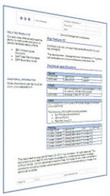 A project charter is a document which summarizes all essential information about a project. What the project is about, it’s goal, scope, the project organization, timeline and other details. It is common to have the project charter signed, both by the client and the contractor (the party executing the project) to show that both parties have the same understanding and expectations towards the project.
A project charter is a document which summarizes all essential information about a project. What the project is about, it’s goal, scope, the project organization, timeline and other details. It is common to have the project charter signed, both by the client and the contractor (the party executing the project) to show that both parties have the same understanding and expectations towards the project.
Usually the project charter is maintained in the form of a Word template.
project plan
The more complex a project is, the harder it is to grasp. Lots of tasks which are interrelated and which have to be carried out in a specific sequence, milestones that we must not lose sight of, parallel projects, holidays and more. The only way to maintain a good overview is to visualize a project with the help of a project plan (check out my project plan template for Excel).
release
The term release is commonly used in software projects, and it describes a version or a number of software updates grouped together. Releases are usually assigned running numbers, as you would find them with software products like Microsoft Windows.
If a release contains significant changes to a software, we speak of a major release (e.g. from 4.20 to 5.0). Smaller changes are packaged in so-called minor releases (e.g. from 4.10 to 4.20).
Scope
Scope is the sum of all the things a project is supposed to deliver or take care of. In project management speak, we talk about something being in scope or out of scope. If something is in scope, it means the project has to take care of it. If it’s not in scope, well, we can forget about it.
It is very important to have a clear understanding of what is in scope and what is not, especially between the customer and the contractor. Scope determines the cost of the project as well as its duration.
Example 1: You are responsible for introducing a new IT system at your company. Does that including bringing data from the old to the new system (= data migration in scope) ? All historical data, or maybe just data from the past 2 years? And who will take care of it? The customer or the contractor?
Example 2: An engineering project has been charged to develop a new type of wind turbines. Under what wind conditions are the turbines expected to operate safely?
If items get added to scope, project cost will increase and you will have to cram more work into the same amount of time.
scope statement
Scope is the sum of all the things a project is responsible for. It is what has been agreed with the customer in terms of features, activities and limitations.
The common way to define or document scope is by creating a scope statement. This is a document which lists in detail which things are expected from the project and which side will take care of it.
Scrum
Scrum is the name of an agile project management methodology (an approach for handling projects) which is used mostly in the software development field. In a Scrum project, the software is built in multiple iterations (so-called sprints), with a number of new features delivered in each sprint. This is the opposite of building a product (i.e. software) over many months as a big bang project.
In Scrum, the customer is always closely involved in the development process, and he can influence the outcome while the product is being built. As a result, the final product is more likely to be what the customer actually wants.
Here’s a nice video explaining what Scrum is:
statement of work (SOW)
A statement of work is a document used in projects to define specific activities, deliverables and timelines an (external) vendor has to fulfill.
Let’s assume you manage a construction project for building a school. A subcontractor is hired to do the electrical wiring in the building. To define responsibilities and tasks of the electrical installations provider, a statement of work is created. It defines exactly which rooms have to be wired including room layouts, the type of sockets to be put up and other technical details.
Also, an SOW will contain terms about your responsibility, e.g. that you have to provide access for the electrical installation provider. In a way, a statement of work is like a contract for a specific piece of work.
sprint
If we use an analogy from sports, the traditional project management style can be compared to a marathon. It takes weeks or even months for a team to design, build or create whatever the project is supposed to work on. You require a software with 100 features? Well, the team of programmers will code for 12 months and once they are done, you’ll get a first glance at the product. This is a long time, and actually 20 of those features would have already solved 70% of your problems. Not really efficient.
Compare this with the modern agile approach to software development, where functionality is delivered not in a “big bang style” (wait ages for the final end product to be delivered), but in small cycles (so-called sprints). A sprint is basically a short phase where a subset of the total number of product features is implemented, tested and delivered. As a result, the customer will get faster access to the product, and he can already use it in his daily business.
stakeholder
Everybody who has a role in the project or who is somehow affected by the project is a project stakeholder. It is very important for a project to know from the start who the stakeholders are. That’s why project managers conduct a stakeholder analysis during project preparation.
Example: In most IT projects you have to deal with a great variety of stakeholders, such as:
- the project team itself
- end-users
- software engineers
- hardware engineers
- line managers
- accounting department
- legal department
- government authorities
End-users are the more obvious type of stakeholder. They have to use the IT system once it’s been rolled out. End-users require training and may have to test the new system before it goes live.
Hardware engineers also may be a stakeholder subgroup. These are the guys who set up new servers or who install updates.
Accounting is usually a stakeholder in every project, as they have to approve your project budget.
Legal department may be involved to make sure the project adheres to internal and external legal standards such as data protection rights and more.
Also government bodies such as tax office / IRS may be a stakeholder group you have to deal with. This can be the case if your new IT system requires approval from government side (for tax compliance reasons).
use case
A use case is a business scenario that has to be considered when building a new product like a software. Example: Customer at ATM enters wrong PIN for several times. How should the software handle this use case? Block the card after 3 wrong attempts? Block card for 24 hours only? Or do nothing?
WBS (work breakdown structure)
A work breakdown structure or WBS is a way to visualize the project scope by breaking it down into its deliverables (or activities). It follows a hierarchical structure, with deliverables and sub-deliverables.
The following image shows a WBS example, with the individual deliverables or activities in the Name column:
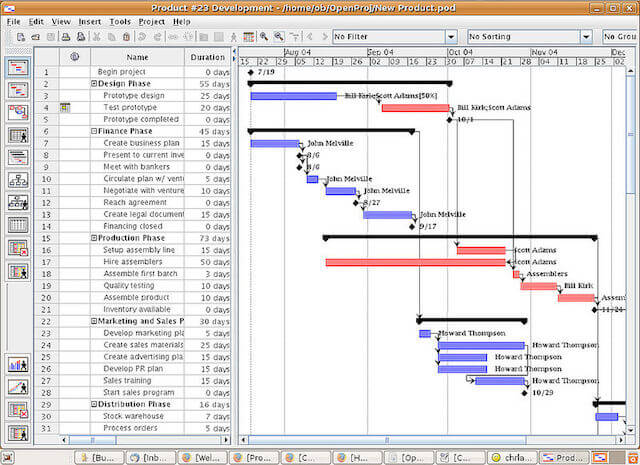
Make sure you read our introduction to work breakdown structures.

